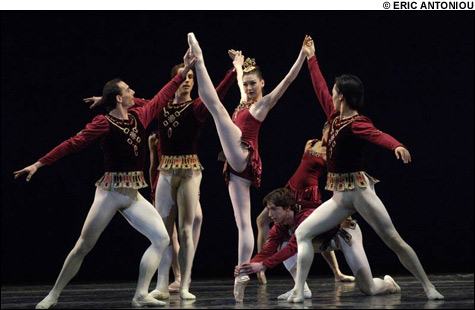Boston Ballet's Jewels at the Wang Theatre.
By JEFFREY GANTZ | March 4, 2009

RUBIES: Kathleen Breen Combes was too much for her hunters in the Bride Stripped Bare by Her Bachelors section; she also impressed Alastair Macaulay of the New York Times.
|
In 1967, George Balanchine created Jewels for New York City Ballet, and in short order this evening-length triptych — Emeralds, Rubies, and Diamonds — became the crown jewel of 20th-century dance, three ballets that add up to one, glitter that’s also gold, a “plotless” work that’s really a bottomless well of stories. Boston Ballet has staged Rubies on four previous occasions, but never Emeralds or Diamonds. Now it’s finally offering a complete Jewels (at the Wang Theatre through March 8), and if Emeralds is so far a little pale, Rubies and Diamonds confirm the company’s international stature, the latter crowned by three laceratingly intimate performances from Kathleen Breen Combes and Yury Yanowsky. Here’s how the first weekend shook out.
EMERALDS | Its eight parts set to Gabriel Fauré’s incidental music for Maurice Maeterlinck’s Pelléas et Mélisande and Edmond de Haraucourt’s Shylock, Emeralds is Paris and France. Its elements are earth and water; its backdrop is hunter green with a champagne-curtain frame; its mood is dreamy, almost somnambulistic. Found in a forest, Maeterlinck’s Mélisande is a mystery woman who loses her crown in a well and her wedding ring in a fountain — in other words, she’s half woman and half water fairy. (In another Maeterlinck play, Mélisande is one of Bluebeard’s escaped wives — Balanchine had fewer wives than Bluebeard, but not by many.) Emeralds’ solo for the first lady is music Fauré wrote for Mélisande at the spinning wheel (spinning straw into gold?); the Sicilienne for the second ballerina represents the scene where Mélisande loses her wedding ring; the second couple’s “clock” movements in the “step” nocturne duet (an kind of unmarked polonaise) suggest that time has come to the forest. Up to that point it’s been the forest before the Fall, but then predators arrive in Paradise, in the form of Fauré’s hunting horns — Man, or Love, or both.In 1967, there were just six sections to Emeralds; in 1976, after Suzanne Farrell had left NYCB and then returned, Balanchine added the “Epithalamion” from Shylock and, as the final section, Fauré’s music for the death of Mélisande. The 10-woman corps disperses; the two lead couples and the pas de trois man and two women process in funereal majesty. The lead men exchange partners; then the pas de trois ladies run out at the back, and the lead women follow them. The three men go to one knee and extend their right hands — only they’re facing opposite to the direction the ladies exited. Women (Farrell) one way, the Eternal Feminine the other.
The first woman has to be liquid (Balanchine set this part on Violette Verdy), and Larissa Ponomarenko, with an attentive Nelson Madrigal as her partner, was. Opening night, Yury Yanowsky and Lorna Feijóo looked ill-matched and ill at ease; partnered with Madrigal on Sunday, Feijóo caught the flow of the music better. Dancing with Carlos Molina Thursday and Lorin Mathis Sunday, Erica Cornejo was rapturous in the Mimi Paul second-lady role. The Boston Ballet Orchestra under Jonathan McPhee made palpable the contrast between oboes and horns, hunted and hunter, women and men.
 Related
Related:
State of the art, Smaller is better, The real deal, More 
- State of the art
Maybe it’s the economy, but Boston Ballet’s third-annual season-opening gala was a sober evening, without the orchestral overture that graced the first two affairs.
- Smaller is better
Next fall, Boston Ballet will move all its performing operations to the Opera House from Citi Performing Arts Center's immense and unfriendly Wang Theatre.
- The real deal
Nineteenth-century ballets are not all alike. But Boston Ballet's Sleeping Beauty is the real McCoy.
- Slideshow: Ballets Russes at the Wang
Boston Ballet performs "Diaghilev's Ballets Russes Centennial Celebration" at the Wang Theater
- Both ears and the tail for this Carmen
"World Passions," the collection of four works that Boston Ballet opened at the Opera House last night, was more pleasant than passionate until Kathleen Breen Combes sashayed out as the title character in Jorma Elo's Carmen .
- Definitions
Boston Ballet’s artistic director, Mikko Nissinen, wants us to think of his company as utterly contemporary, but it’s a tricky balance to pull off.
- Plugging in
For the past six years, Festival Ballet Providence has presented an evening of short works, Up Close on Hope , in their Black Box Theater on Hope Street.
- Smaller, bigger, better
Is Boston in the midst of a ballet boom? You could certainly believe that if you attended Boston Ballet’s fourth annual season-opening gala last Saturday.
- Photos: Boston Ballet's World Passions
Photos of the Boston Ballet's "World Passions" collection, including Jorma Elo's Carmen ; Helen Pickett's Tsukiyo ; Viktor Plotnikov's Rhyme ; and Marius Petipa's Paquita.
- Scenes from the city
I missed more things in two and a half days last week than I managed to take in, so whatever I might infer about dance in the New York vortex could have come out a different way if I’d reversed my priorities.
- Not quite Nina
On hearing the opening notes of the Kronos Quartet composition and seeing the dancers lit in sunny yellow, I feared we were about to be subjected to one of those “up with people” ballets.
- Less

 Topics
Topics:
Dance
, Entertainment, Pyotr Ilyich Tchaikovsky, Edward Villella, More  , Entertainment, Pyotr Ilyich Tchaikovsky, Edward Villella, San Francisco Ballet, Suzanne Farrell, Laura Jacobs, Maurice Maeterlinck, wang theatre, wang theatre, Jewels, Less
, Entertainment, Pyotr Ilyich Tchaikovsky, Edward Villella, San Francisco Ballet, Suzanne Farrell, Laura Jacobs, Maurice Maeterlinck, wang theatre, wang theatre, Jewels, Less 